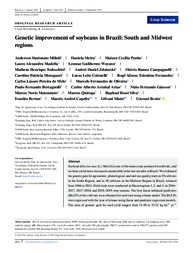Genetic improvement of soybeans in Brazil: South and Midwest regions
Genetic improvement of soybeans in Brazil: South and Midwest regions
Autoria: MILIOLI, A. S.; MEIRA, D.; PANHO, M. C.; MANDELLA, L. A.; WOYANN, L. G.; TODESCHINI, M. H.; ZDZIARSKI, A. D.; CAMPAGNOLLI, O. R.; MENEGAZZI, C. P.; COLONELLI, L. L.; FERNANDES, R. A. T.; MELO, C. L. P. de; OLIVEIRA, M. F. de; BERTAGNOLLI, P. F.; ARIAS, C. A. A.; GIASSON, N. F.; MATSUMOTO, M. N.; QUIROGA, M; SILVA, R. R.; BERTAN, I.; CAPELIN, M. A.; MATEI, G.; BENIN, G.
Resumo: Abstract: Soybean [Glycine max (L.) Merril] is one of the main crops produced worldwide, and on-farm yields have increased considerably in the last decades in Brazil. We evaluated the genetic gain for agronomic, phenological, and end-use quality traits in 29 cultivars in the South Region, and in 38 cultivars in the Midwest Region in Brazil, released from 1966 to 2011. Field trials were conducted in Macroregions 1, 2, and 4, in 2016?2017, 2017?2018, and 2018?2019 crop seasons. The best linear unbiased predictors (BLUP) of the cultivars were obtained for each trait using a linear model. The BLUPs were regressed with the year of release using linear and quadratic regression models. The rates of genetic gain for seed yield ranged from 11.98 to 15.31 kg ha?1 yr?1 (0.33 to 0.42% yr?1) in the South Region, and from 13.58 to 21.84 kg ha?1 yr?1 (0.47 to 0.77% yr?1) in the Midwest Region. New cultivars presented taller plants and more seed oil content, oil and protein yield, and lower seed weight, days to flowering, days to maturity, and seed protein content than old cultivars in the South Region, although with differences between the Macroregions. In the Midwest Region, new cultivars showed higher seed oil content, oil and protein yield, and lower bottom pod height and seed protein content than old cultivars. Our results showed that breeding programs have been efficient to improve soybean yield and other traits across the years, without yield plateaus in sight.
Ano de publicação: 2022
Tipo de publicação: Artigo de periódico
Unidade: Embrapa Trigo
Palavras-chave: Melhoramento Genético Vegetal, Plant genetics, Produtividade, Soja, Soybeans
Observações
1 - Por padrão são exibidas publicações dos últimos 20 anos. Para encontrar publicações mais antigas, configure o filtro ano de publicação, colocando o ano a partir do qual você deseja encontrar publicações. O filtro está na coluna da esquerda na busca acima.
2 - Para ler algumas publicações da Embrapa (apenas as que estão em formato ePub), é necessário ter, no celular ou computador, um desses softwares gratuitos. Sistemas Android: Google Play Livros; IOS: iBooks; Windows e Linux: software Calibre.
Acesse outras publicações
Acesse a Base de Dados da Pesquisa Agropecuária (BDPA) para consultar o acervo completo das bibliotecas da Embrapa.

